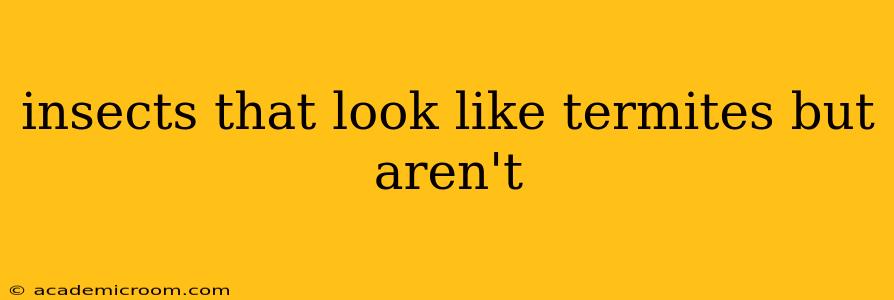Termites are notorious for the damage they inflict on wooden structures, but many insects mimic their appearance, causing confusion and potentially delaying crucial pest control measures. This guide explores several insects frequently mistaken for termites, highlighting their key differences to help you accurately identify the culprits and take appropriate action. Understanding these distinctions is crucial for effective pest management and preventing significant property damage.
What are the Common Insects Mistaken for Termites?
Several insect species share similar physical characteristics with termites, leading to misidentification. These imposters often belong to different insect orders and exhibit distinct behaviors. The most common culprits include:
- Ants: Certain ant species, especially carpenter ants, are often confused with termites. Their size and coloring can be remarkably similar.
- Booklice (Psocoptera): These tiny insects are often found in damp, humid areas and can be mistaken for subterranean termites due to their size and pale coloring.
- Other Isoptera (not termites): While termites belong to the order Isoptera, other insects within this order also share similar traits but are not the destructive pests commonly known as termites.
How to Tell Termites Apart from Ants: A Detailed Comparison
This is arguably the most important distinction to make. While both can cause damage to wood, their behaviors and physical characteristics differ significantly:
Body Shape:
- Termites: Have a straight, uniform body with a broad waist. Their bodies are generally softer and less defined.
- Ants: Possess a noticeably constricted waist (a thin petiole connecting the thorax and abdomen) with a more defined body. They have a harder exoskeleton.
Antennae:
- Termites: Their antennae are straight and bead-like.
- Ants: Have bent or elbowed antennae.
Wings:
- Termites: (Swarmers) Have four equal-sized wings that are longer than their bodies. The wings are easily shed and leave behind stubby wing remnants.
- Ants: (Swarmers) Have two pairs of wings, but the front pair is significantly larger than the hind pair.
Are Booklice Termites?
No, booklice are not termites. They belong to a completely different order of insects (Psocoptera). While they might inhabit similar environments (damp, humid areas with decaying organic matter), they are far smaller and do not feed on wood in the same destructive way that termites do. Booklice primarily feed on mold, mildew, and other organic debris. Their damage is generally far less significant than that of termites.
What other insects might be mistaken for termites?
While ants and booklice are the most common culprits, other less frequently encountered insects might also be mistaken for termites. Certain beetles, especially those found in damp wood, may superficially resemble termites in size and color. Accurate identification often requires closer examination of their body structure, behavior, and the type of damage they cause. A professional pest control inspection can eliminate any doubt.
How to Identify Termite Damage vs. Other Insect Damage
Termite damage is typically characterized by:
- Mud tubes: These are protective tunnels constructed by subterranean termites to travel from the ground to their food source.
- Frass: Termite droppings, which are small, pellet-shaped particles.
- Hollowed-out wood: Termites consume the wood from the inside, leaving behind a thin shell. This is in contrast to carpenter ants, which create more neatly excavated tunnels.
In contrast, other insects may leave different types of damage, such as larger, more irregular holes or distinct sawdust-like frass.
When to Call a Pest Control Professional
If you suspect you have a termite infestation or are unsure about the identity of the insects you've found, it's best to consult a professional pest control company. They possess the expertise and equipment to accurately identify the insects and recommend the appropriate treatment strategy. Early detection and professional intervention are crucial to preventing significant structural damage and costly repairs.
